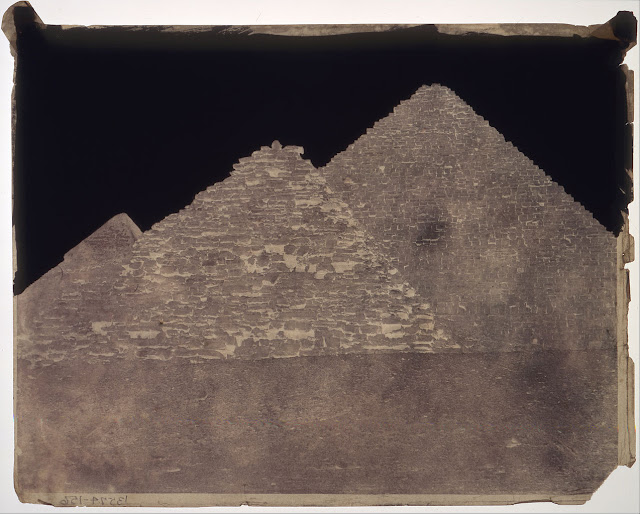 |
| John Shaw Smith Two small pyramids with the Pyramid of Ekphrenes in the distance 1852 calotype negative George Eastman House, Rochester, New York |
"The pyramid represents a crystal in its composition of discrete, sharp-edged surfaces. But it is not a regular polyhedron, for it displays symmetry only across the central axis, not in the upper and lower halves. Here symmetry is partial, as in organic things, rather than absolute. If I turn the pyramid on its side, even the bilateral symmetry disappears. How is this explained? The pyramid exhibits two distinct directionalities, one through which it tapers, a second through which it broadens. The broader direction represents gravity, which pulls everything toward the ground, while the narrower one signals the power of growth, which strives to draw things away from the ground. This growth force doubtless represents a movement inherent in the material. This can no longer be inorganic. The pyramid is not a crystal but an octahedron whose upward movement is halted."
"We find internal movement already in the pyramid, though the essential properties of inorganic matter still cling to it. Because the pyramid dispenses with curvature despite being essentially organic, it is a transitional motif. It also departs from symmetry. But something else takes its place: the force of upward growth, counteracting gravitational pull. The pyramid's shape represents the end of the battle. If the growth force alone were present, at a certain point the pyramid would taper off into a tiny thread. The force of gravity engenders the formal beauty of the pyramid. The pyramid would appear displeasing if it were either excessively slender or excessively stout. It must exhibit balance, a proper middle between the extremes – then it has proportion."
– from Historical Grammar of the Visual Arts, a course of lectures delivered by Aloïs Riegl in 1899 at the University of Vienna, translated by Jaqueline E. Jung and published in English by Zone Books in 2004
 |
| Henri Béchard Climbing the Great Pyramid ca. 1860-80 photograph Rijksmuseum, Amsterdam |
 |
| Adrien Dauzats Great Pyramid, Giza ca. 1830 oil on canvas Metropolitan Museum of Art, New York |